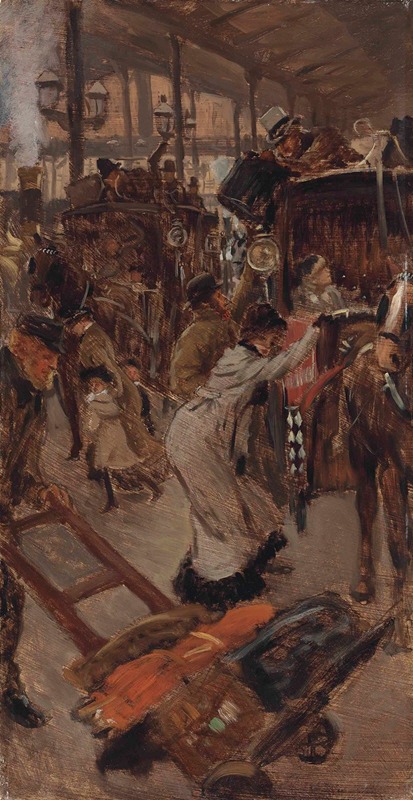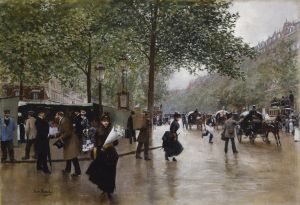
The Cab Road, Victoria Station
A hand-painted replica of James Tissot’s masterpiece The Cab Road, Victoria Station, meticulously crafted by professional artists to capture the true essence of the original. Each piece is created with museum-quality canvas and rare mineral pigments, carefully painted by experienced artists with delicate brushstrokes and rich, layered colors to perfectly recreate the texture of the original artwork. Unlike machine-printed reproductions, this hand-painted version brings the painting to life, infused with the artist’s emotions and skill in every stroke. Whether for personal collection or home decoration, it instantly elevates the artistic atmosphere of any space.
"The Cab Road, Victoria Station" is a painting by the French artist James Tissot, completed in 1877. Tissot, known for his detailed and vibrant depictions of contemporary life, was a prominent figure in both the French and British art scenes during the late 19th century. His works often capture the nuances of social interactions and the fashion of the time, making them valuable historical documents as well as artistic achievements.
This particular painting is part of Tissot's series of works that explore the theme of modern life in London, where he moved in 1871 after the Franco-Prussian War. "The Cab Road, Victoria Station" is a quintessential example of Tissot's interest in the bustling urban environment and the social dynamics within it. The painting depicts a scene at Victoria Station, one of London's major railway termini, which was a hub of activity and a symbol of the modern age of travel and communication.
In the painting, Tissot captures the energy and movement of the station's cab road, where horse-drawn carriages are lined up to pick up and drop off passengers. The composition is characterized by its attention to detail and the artist's skillful use of perspective, drawing the viewer's eye into the depth of the scene. The figures in the painting are dressed in the fashionable attire of the period, reflecting Tissot's keen interest in contemporary fashion and his ability to render textiles and clothing with great precision.
The painting is notable for its vibrant color palette and the way Tissot uses light to create a sense of atmosphere. The interplay of light and shadow adds depth to the scene and highlights the various textures and materials present, from the polished surfaces of the carriages to the fabric of the passengers' clothing. Tissot's technique combines elements of realism with a slightly impressionistic touch, capturing both the physical details and the transient nature of the moment.
"The Cab Road, Victoria Station" is also significant for its portrayal of the social interactions and class distinctions of the time. The painting includes a range of characters, from well-dressed gentlemen and ladies to working-class cab drivers, each engaged in their own activities yet part of the larger tapestry of urban life. This reflects Tissot's interest in the social fabric of the city and his ability to convey complex narratives through his art.
Today, "The Cab Road, Victoria Station" is appreciated not only for its artistic merit but also for its historical value, offering insights into the social and cultural dynamics of Victorian London. The painting is housed in a private collection, and while it may not be as widely known as some of Tissot's other works, it remains an important example of his contribution to the genre of modern-life painting. Through works like this, Tissot has left a lasting legacy, providing a window into the world of the 19th century with all its vibrancy and complexity.


















